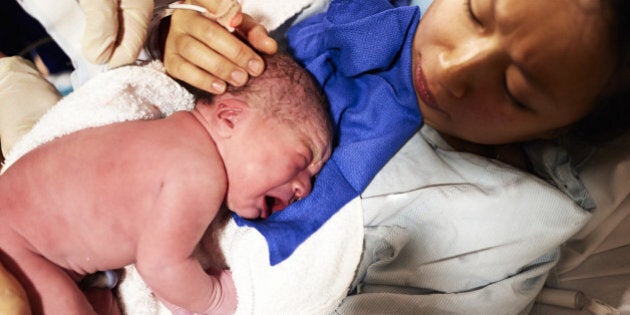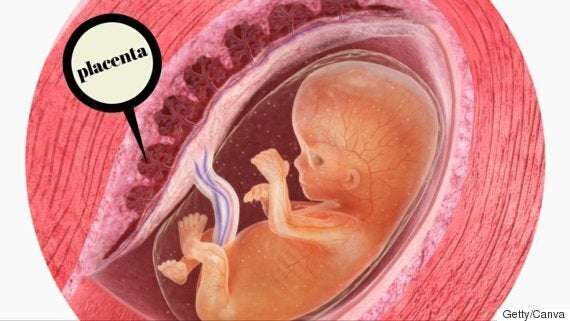
The placenta is the lifeline between a mother and baby and is considered “the least understood human organ but arguably one of the most important.”
The placenta starts to develop shortly after the egg is fertilized, and it attaches itself to the uterine wall. It delivers nutrients to the baby during pregnancy and removes unnecessary waste, like carbon dioxide.

But what else does the placenta do? Here are 11 facts about after-birth that you might not have known.
1. The placenta can provide immunity to the baby long after birth.
During pregnancy, the placenta transfers antibodies from the mother to the fetus that provide immune protection. These antibodies can provide three to six months of immunity for the baby after being born.
2. It acts as lungs for the baby.
When you breathe, your body provides oxygen to your organs and tissues. During pregnancy, the mother does the same thing for the fetus through the placenta. The oxygen passes through the placenta and the umbilical cord to be delivered into the baby’s bloodstream. The placenta also acts as the baby’s kidneys by filtering out waste.
3. Some women ingest their placenta.
Most mammals, other than humans, eat their own placenta. And many women have started ingesting them, as well. Some women choose to eat the placenta raw, others cook it and some even ingest it via capsules. The practice is supposed to help with postpartum depression, pain relief and other complications, but there is no known medical evidence to support this.
4. The placenta has spiritual significance in some cultures.
In different parts of the world, the placenta is seen as more than just a disposable organ. In Nepal, the placenta is considered a friend to the baby, in Malaysia it’s an elder sibling, a twin in Nigeria, and part of the baby itself in Hawaii.
5. Identical twins may or may not share a placenta.
When giving birth to identical twins, the number of placentas is determined by when the fertilized egg splits. If the egg splits before the placenta develops, each baby will have its own placenta. If the egg splits after it develops, both babies will be sustained by one placenta. With fraternal twins, there will always be two placentas.
6. Scientists study the placenta to better understand cancer.
Pregnancy progresses in a similar way to a tumour, so scientists are able to learn more about cancer by studying the placenta. Unlike an organ transplant, the placenta is able to develop in the body without being attacked by the immune system. By studying the placenta, researchers can learn more about how tumours have the ability to grow without intervention from the immune system.
7. Both the mother and baby’s blood passes through the placenta, but they don’t mix.
The mother and baby exchange oxygen and nutrients through the placenta, but if their blood was to intermingle it could cause problems with the pregnancy. The mother’s immune system would create antibodies to get rid of the baby’s blood and it could destroy the pregnancy. Instead, the blood passes through separate arteries. Incredibly, about 20 per cent of the mother’s blood flows through the placenta every single minute.
8. Some women have chosen to leave the placenta attached to the baby after delivery.
“Lotus birth” is the practice of keeping a newborn baby attached to the placenta until the umbilical cord naturally falls off. One mother explained that leaving the umbilical cord intact could allow for additional nutrient exchange between the placenta and the baby because the placenta can survive for a few minutes after birth. She also said that the practice has “spiritual benefits.”
However, medical professionals claim that there are no benefits, and it could actually be dangerous. The placenta becomes dead tissue shortly after birth and is prone to infection.
9. Placenta previa can cause delivery issues.
Placenta previa occurs when the placenta blocks the opening to the mother’s cervix and can cause bleeding during pregnancy or delivery. Women who have delivered via C-section, are carrying more than one fetus, or who are age 35 or older are at higher risk of placenta previa. Women who have this often require a C-section to ensure a safe delivery.
10. Babies can send cells through the placenta that protect and heal the mother’s organs.
Fetal cells can transfer to the mother during pregnancy, and they seem to target sites of injury. These cells have been found in the skin, liver, kidney and bone marrow in healthy women as well as women with autoimmune diseases. They have also been found in women with diseases like hepatitis C and cervical cancer. There is evidence that the presence of these cells is increased in diseased tissues.
11. The placenta is made by both Mom and Dad.
Although the placenta develops inside the mother, the father actually helps to create the organ. When the sperm fertilizes the egg, a blastocyst is formed. This then becomes the placenta and the baby.
ALSO ON HUFFPOST:
